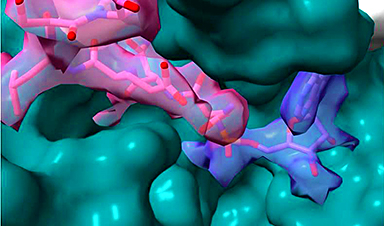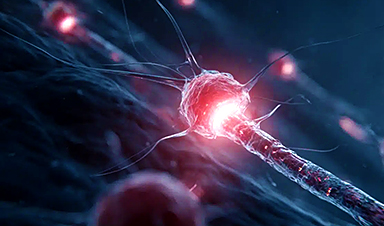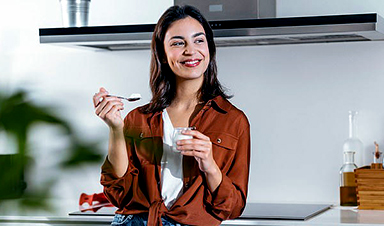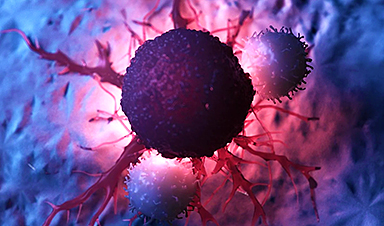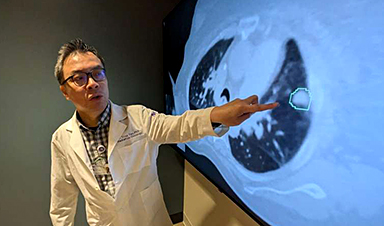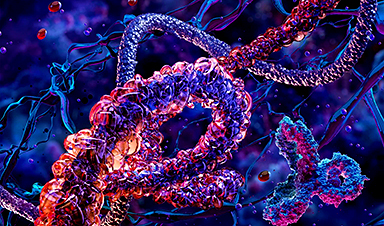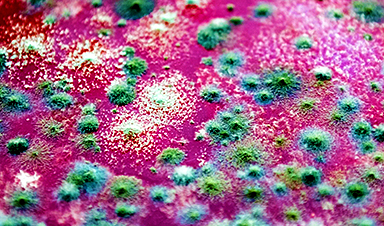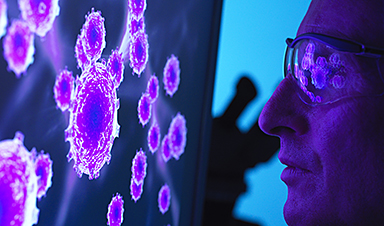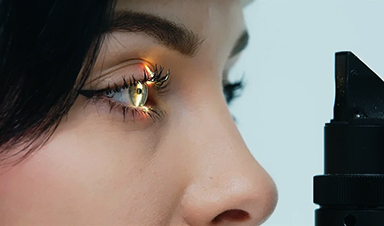A new study conducted by the Wilhelm Lab at the University of Oklahoma examines a promising development in biomedical nanoengineering. Published in Advanced Materials, the study explores new findings on the transportation of cancer nanomedicines into solid tumors.
A frequent misconception about many malignant solid tumors is that they are comprised only of cancerous cells. However, solid tumors also include healthy cells, such as immune cells and blood vessels. These blood vessels are nutrient transportation highways that tumors need to grow, but they can also be a pathway for medicine delivery, including for cancer nanomedicines.
Blood vessels, and the endothelial cells within them, are the transportation method examined in the new study led by Lin Wang, Ph.D., who was a postdoctoral research associate in the Wilhelm Lab while conducting the study and is the first author of the publication. Endothelial cells line blood vessels and manage the exchange between the bloodstream and surrounding tissues. These cells are the first barrier that the nanotechnologies encounter in the process of being transported into tumors.
The researchers found that endothelial cells in breast cancer tumors are two times more likely to interact with medicine-carrying nanoparticles than endothelial cells in healthy breast tissue. Wang said that the tumor endothelial cells have more transport features than the healthy endothelial cells, making them ideal conduits.
“If you know that the same cell type in tumor tissues is two times more likely to interact with your drug carriers than in healthy tissue, then in theory, you should be able to target those cells to get even more nanoparticles delivered into the tumor,” said Stefan Wilhelm, Ph.D., associate professor in the Stephenson School of Biomedical Engineering and corresponding author of the study.
The research was conducted on endothelial cells isolated from breast cancer tissues and isolated from healthy breast tissues. The next steps for the research will involve examining how the nanoparticles react in the context of the whole tissue architecture.
“Cell-culture level experiments are only so good at trying to recapitulate what is happening in the body,” said Wilhelm. “Working with colleagues at OU Health Sciences, we hope to get our hands on not just cells but the entire tumor tissue.”
The research team is working with the Stephenson Cancer Center to set up an ethics protocol allowing the lab to access stored samples of cancer tissue rather than just isolated cells. The Wilhelm Lab is focused on studying nanomedicine and using nanoparticles for drug delivery and diagnostics. In particular, the team is interested in studying the delivery of drugs into solid tumor tissues.
From an engineering perspective, a unique advantage of using nanoparticles for drug delivery is that they are small and flexible enough to be designed as direct delivery vehicles. In a laboratory setting, the nanoparticles are often designed as tiny spheres and loaded with the necessary drugs. Then, in clinics, they are often administered intravenously to patients. These drugs circulate through the bloodstream, and some of them enter the tumor.
There are challenges associated with this type of medicine transportation. One is that these nanoparticles circulate throughout the body, and consequently, they accumulate in other organs—called off-target organs—such as the liver, spleen and kidneys. Since these organs filter blood, they remove the nanoparticles, which are often considered foreign objects by the body.
The field of nanomedicine has been around for more than 40 years, and there are tens of thousands of publications on using nanoparticles to treat cancers at the preclinical stage. But there is a disconnect between the number of preclinical publications and the number of FDA-approved formulations of nanoparticles that are actually used in clinics.
Of those approved formulations, a fraction are used for solid tumors, and most treat liquid tumors, such as leukemia. Wilhelm speculates that this is partially because there is a lack of full understanding of how the nanoparticle delivery process works.
“And if you don’t understand something fully, it’s hard to develop solutions to those problems,” said Wilhelm.
“Researchers have started to go back to the fundamentals of nanomedicine development to understand the translation from the pre-clinical to the clinical space. Our lab wants to focus on these fundamentals to better understand the field and the delivery mechanisms specifically. If we understand these fundamentals, we can contribute even more to the field,” said Wang.
According to Wilhelm, the next big question is this: now that the lab has quantified and shown that endothelial cells are more likely to interact with and transport these nanomedicines, how can that transportation be made more efficient and specific to advance clinical cancer treatments? As these questions are answered, the opportunities for future advances in cancer health care will grow.
“We are just scratching the surface by using breast cancer as our model cancer system, but our findings may be relevant for other types of solid tumors as well,” said Wilhelm.
More information: Lin Wang et al, Primary Human Breast Cancer‐ Associated Endothelial Cells Favor Interactions with Nanomedicines, Advanced Materials (2024). DOI: 10.1002/adma.202403986
Journal information: Advanced Materials
News
Team finds flawed data in recent study relevant to coronavirus antiviral development
The COVID pandemic illustrated how urgently we need antiviral medications capable of treating coronavirus infections. To aid this effort, researchers quickly homed in on part of SARS-CoV-2's molecular structure known as the NiRAN domain—an [...]
Drug-Coated Neural Implants Reduce Immune Rejection
Summary: A new study shows that coating neural prosthetic implants with the anti-inflammatory drug dexamethasone helps reduce the body’s immune response and scar tissue formation. This strategy enhances the long-term performance and stability of electrodes [...]
Scientists discover cancer-fighting bacteria that ‘soak up’ forever chemicals in the body
A family of healthy bacteria may help 'soak up' toxic forever chemicals in the body, warding off their cancerous effects. Forever chemicals, also known as PFAS (per- and polyfluoroalkyl substances), are toxic chemicals that [...]
Johns Hopkins Researchers Uncover a New Way To Kill Cancer Cells
A new study reveals that blocking ribosomal RNA production rewires cancer cell behavior and could help treat genetically unstable tumors. Researchers at the Johns Hopkins Kimmel Cancer Center and the Department of Radiation Oncology and Molecular [...]
AI matches doctors in mapping lung tumors for radiation therapy
In radiation therapy, precision can save lives. Oncologists must carefully map the size and location of a tumor before delivering high-dose radiation to destroy cancer cells while sparing healthy tissue. But this process, called [...]
Scientists Finally “See” Key Protein That Controls Inflammation
Researchers used advanced microscopy to uncover important protein structures. For the first time, two important protein structures in the human body are being visualized, thanks in part to cutting-edge technology at the University of [...]
AI tool detects 9 types of dementia from a single brain scan
Mayo Clinic researchers have developed a new artificial intelligence (AI) tool that helps clinicians identify brain activity patterns linked to nine types of dementia, including Alzheimer's disease, using a single, widely available scan—a transformative [...]
Is plastic packaging putting more than just food on your plate?
New research reveals that common food packaging and utensils can shed microscopic plastics into our food, prompting urgent calls for stricter testing and updated regulations to protect public health. Beyond microplastics: The analysis intentionally [...]
Aging Spreads Through the Bloodstream
Summary: New research reveals that aging isn’t just a local cellular process—it can spread throughout the body via the bloodstream. A redox-sensitive protein called ReHMGB1, secreted by senescent cells, was found to trigger aging features [...]
AI and nanomedicine find rare biomarkers for prostrate cancer and atherosclerosis
Imagine a stadium packed with 75,000 fans, all wearing green and white jerseys—except one person in a solid green shirt. Finding that person would be tough. That's how hard it is for scientists to [...]
Are Pesticides Breeding the Next Pandemic? Experts Warn of Fungal Superbugs
Fungicides used in agriculture have been linked to an increase in resistance to antifungal drugs in both humans and animals. Fungal infections are on the rise, and two UC Davis infectious disease experts, Dr. George Thompson [...]
Scientists Crack the 500-Million-Year-Old Code That Controls Your Immune System
A collaborative team from Penn Medicine and Penn Engineering has uncovered the mathematical principles behind a 500-million-year-old protein network that determines whether foreign materials are recognized as friend or foe. How does your body [...]
Team discovers how tiny parts of cells stay organized, new insights for blocking cancer growth
A team of international researchers led by scientists at City of Hope provides the most thorough account yet of an elusive target for cancer treatment. Published in Science Advances, the study suggests a complex signaling [...]
Nanomaterials in Ophthalmology: A Review
Eye diseases are becoming more common. In 2020, over 250 million people had mild vision problems, and 295 million experienced moderate to severe ocular conditions. In response, researchers are turning to nanotechnology and nanomaterials—tools that are transforming [...]
Natural Plant Extract Removes up to 90% of Microplastics From Water
Researchers found that natural polymers derived from okra and fenugreek are highly effective at removing microplastics from water. The same sticky substances that make okra slimy and give fenugreek its gel-like texture could help [...]
Instant coffee may damage your eyes, genetic study finds
A new genetic study shows that just one extra cup of instant coffee a day could significantly increase your risk of developing dry AMD, shedding fresh light on how our daily beverage choices may [...]

